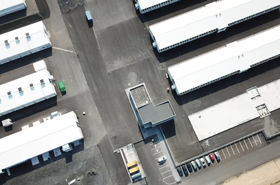Estonian power infrastructure developer Skeleton Technologies has officially opened its €220 million ($192.5m) SuperFactory in Markranstädt, near Leipzig, Germany.
The company develops supercapacitor systems for the utility and AI data center market. The system is a high-power energy-storage device designed to handle sharp load fluctuations in grids and AI data centers in under a millisecond.
According to its CEO, Taavi Madiberk, the company is already shipping supercapacitor systems to major US hyperscalers from its German production lines, with additional systems deployed across European grids in partnership with Siemens, Hitachi Energy, and General Electric.
The facility is part of Skeleton’s fully European value chain and produces the company’s curved-graphene supercapacitors. According to Madiberk, the device contains no lithium, cobalt, manganese, or other critical or flammable materials, allowing it to be vertically integrated, covering raw materials, cell production, module assembly, and power electronics, with an annual capacity of up to 12 million cells.
Speaking to DCD, Madiberk said that the decision to locate the plant in Saxony was shaped by the region’s industrial ecosystem rather than simply logistics alone. “Leipzig and Saxony have the highest density of Fraunhofer institutes in Germany and a long tradition of high-quality, high-volume manufacturing. We wanted the best of Estonian entrepreneurship with the best of German engineering. That’s why we chose Germany,” he said.
While the company’s technology is used across both the automotive sector and electrical grids, its fastest-growing customer segment is AI infrastructure. Due to the uneven power profile of AI data centers, operators face steep and frequent load swings that stress both site power systems and local grids. Skeleton claims that its GrapheneGPU solution, which uses supercapacitors as fast-response buffers, can play a crucial role in maintaining uptime.
“AI loads fluctuate massively – full power in parallel computing and almost zero during data transfer. By smoothing those peaks, we can deliver up to 40 percent energy savings,” Madiberk told DCD. “With our fast-response systems, we can cut the required grid capacity for a GPU cluster almost in half. For operators, it’s a capex question. For Europe, it’s also an energy-security question.”
Madiberk added that by removing the need for “GPU burn,” which is the intentional throttling or energy dumping to manage thermal loads, operators can extract greater real performance from the same silicon. “By eliminating GPU burn, we can increase actual GPU computing output by up to 40 percent. Cooling can remove heat from the outside, but nothing removes heat from inside the GPU. That’s why this matters,” he said.
While based in Europe, the company intends to expand further afield. “The market is clearly in the US. Our next step is opening our first manufacturing facility in California early next year,” Madiberk said. “Given the geopolitical climate, mission-critical components need to be as close to the customer as possible.”
Madiberk also noted the growth potential within the Middle East, with Saudi Arabia earmarked as a potential hub.
The opening of the Leipzig plant follows the opening of the company’s SuperBattery manufacturing site in Varkaus, Finland.
Skeleton was launched in 2009 in Tartu, Estonia. Its first customer was the European Space Agency and has seen uptake across the German automotive sector, with use in BMW’s i7 and M-series models.
Investors in the firm include Siemens Financial Services (SFS), Marubeni Corporation, FirstFloor Capital, and EIT InnoEnergy.
Read the orginal article: https://www.datacenterdynamics.com/en/news/supercapacitor-developer-skeleton-opens-leipzig-factory-in-germany-targets-ai-data-center-market/









